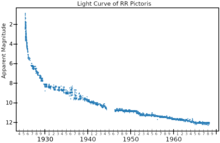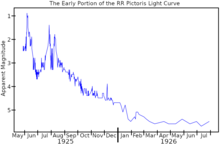This is the current revision of this page, as edited by Joriki (talk | contribs) at 06:43, 7 October 2024 (added Category:Nova remnants using HotCat). The present address (URL) is a permanent link to this version.
Revision as of 06:43, 7 October 2024 by Joriki (talk | contribs) (added Category:Nova remnants using HotCat)(diff) ← Previous revision | Latest revision (diff) | Newer revision → (diff) 1925 Nova seen in the constellation Pictor
 Location of RR Pictoris (circled in red)
Location of RR Pictoris (circled in red) | |
| Observation data Epoch J2000.0 Equinox J2000.0 (ICRS) | |
|---|---|
| Constellation | Pictor |
| Right ascension | 06 35 36.063 |
| Declination | −62° 38′ 22.29″ |
| Apparent magnitude (V) | 1.2Max. 12.5Min. |
| Astrometry | |
| Distance | 1,670 −26 ly (511+8 −8 pc) |
| Characteristics | |
| Variable type | Classical Nova |
| Other designations | |
| RR Pic, HIP 31481, TYC 8899-1342-1, Nova Pic 1925, AAVSO 0634-62, Gaia DR2 5477422099543150592 | |
| Database references | |
| SIMBAD | data |


RR Pictoris, also known as Nova Pictoris 1925, is a cataclysmic variable star system that flared up as a nova that lit up in the constellation Pictor in 1925. It was discovered by South African amateur astronomer R. Watson who lived in Beaufort West. At 05:50 AM on 25 May 1925, Mr. Watson was walking to work and noticed a star that he did not recognize in line with the stars α Crucis and β Carinae. He consulted his copy of Norton's Star Atlas, and realized that the unfamiliar star was a nova. Fortuitously, Mr. Watson was employed as a telegraph operator, and he promptly sent a telegram describing his discovery to the Royal Observatory at Cape Town. This quick reporting of the event allowed southern observatories to obtain spectra of the nova before it had reached maximum brightness.
At the time of its discovery, RR Pictoris had an apparent magnitude of 2.3. It continued to brighten to magnitude 1.2, which it reached on 9 June 1925. It dimmed to magnitude 4 by 4 July, but brightened again to 1.9 on 9 August. Six months after its peak brightness, RR Pictoris faded to be invisible to the unaided eye, and was magnitude 12.5 by 1975. RR Pictoris is classified as a slow nova and its light curve exhibits positive superhumps, meaning superhumps with a period a few percent (8.6% in this case) longer than the star system's orbital period.
Measurements by the Gaia spacecraft show that the RR Pictoris system is around 510 parsecs (1670 light-years) from the Earth.
Novae are close binary systems composed of a white dwarf and secondary star that is so close it is filling up its Roche lobe with stellar material, which is then transferred onto the first star's accretion disc. Once this material reaches a critical mass, it ignites and the system brightens tremendously. The two stars of RR Pictoris orbit each other every 3.48 hours. Calculations of the speed suggest the secondary star is not dense enough for its size to still be on the main sequence, so it itself must have begun expanding and cooling already as its core has run out of hydrogen fuel.
Small variations in the observed orbital period suggest that RR Pictoris system may include a low mass (0.25 M⊙) third star orbiting the close binary pair with a period of about 70 years.
A small (< 30 arc second) filamentary nebula surrounds the nova, and comparisons of images taken several years apart have allowed its rate of expansion to be measured.
References
- ^ "RR Pic". SIMBAD. Centre de données astronomiques de Strasbourg. Retrieved 5 December 2020.
- ^ Schaefer, Bradley E. (20 September 2018). "The distances to Novae as seen by Gaia". Monthly Notices of the Royal Astronomical Society. 481 (3): 3033–3051. arXiv:1809.00180. Bibcode:2018MNRAS.481.3033S. doi:10.1093/mnras/sty2388.
- Vandenbos, W.H. (1947). "Nova Pictoris 1925". Monthly Notes of the Astronomical Society of South Africa. 6: 2–4. Bibcode:1947MNSSA...6....2V. Retrieved 5 December 2020.
- Barritt, Leon (February 1926). "Nova Pictoris, 1925". The Monthly Evening Sky Map. XXI: 1.
- Burnham, Robert (2013) . Burnham's Celestial Handbook, Volume Three: An Observer's Guide to the Universe Beyond the Solar System. New York, New York: Courier Dover Publications. pp. 1460–62. ISBN 978-0-486-31803-5.
- "RR Pictoris". aavso.org. American Association of Variable Star Observers. Retrieved 5 December 2020.
- Fuentes-Morales, I.; Vogt, N.; Tappert, C.; Schmidtobreick, L.; Hambsch, F.J.; Vuckovic, M. (February 2018). "Photometric long-term variations and superhump occurrence in the Classical Nova RR Pictoris". Monthly Notices of the Royal Astronomical Society. 474 (2): 2493–2501. arXiv:1710.06543. doi:10.1093/mnras/stx2838.
- Ribeiro, Fabíola M. A.; Diaz, Marcos P. (2006). "A Tomographic Study of the Classical Nova RR Pictoris". Publications of the Astronomical Society of the Pacific. 118 (839): 84–93. arXiv:astro-ph/0510042. Bibcode:2006PASP..118...84R. doi:10.1086/498458. JSTOR 498458. S2CID 18244357.
- Vogt, N.; Schreiber, M.R.; Hambsch, F.J.; Retamales, G.; Tappert, C.; Schmidtobreick, L.; Fuentes-Morales, I. (January 2017). "The Orbital Ephemeris of the Classical Nova RR Pictoris: Presence of a Third Body?". Publications of the Astronomical Society of the Pacific. 129 (971): 014201. arXiv:1609.05274. Bibcode:2017PASP..129a4201V. doi:10.1088/1538-3873/129/971/014201. S2CID 119183582.
- Williams, R.E.; Gallagher, J.S. (March 1979). "Spectrophotometry of filaments surrounding nova RR Pictoris 1925". The Astrophysical Journal. 228: 482–490. Bibcode:1979ApJ...228..482W. doi:10.1086/156869. Retrieved 5 December 2020.
- Duerbeck, H.W. (December 1987). "The large intractable nova shells". The Messenger. 80: 8–11. Bibcode:1979ApJ...228..482W. doi:10.1086/156869. Retrieved 5 December 2020.
External links
| Constellation of Pictor | |||||||||||
|---|---|---|---|---|---|---|---|---|---|---|---|
| Stars |
| ||||||||||
| |||||||||||
| Galaxies |
| ||||||||||